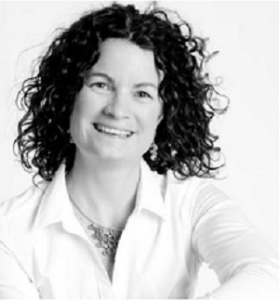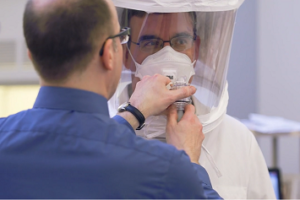When we started the Faces of EHS series back in January, we envisioned it as a bi-weekly series where we could chat with professionals who are on the front lines of environment, health, and safety (EHS) work. It was our goal to get myriad perspectives on the breadth and scope of what EHS pros are doing, and learn about some of the current trends and catch a glimpse of where the industry is headed. Now, after a brief COVID-19-induced hiatus, we at the EHS Daily Advisor would be remiss if we didn’t use our return to the series to get some perspective on the current moment. We were fortunate enough to chat with Roberta Smith, MSPH, RN, CIH, COHN-s, CIC, the Director of Worker Health for Cority Axion Health, who brings her vast public health background to bear on the current moment as well as in her everyday work.

Could you tell us a little bit about your career path? How did you end up in EHS?
I have had a pretty diverse career. Each experience has built on previous experiences, and I’ve been very lucky to have had terrific mentors along my path. My first bachelor’s degree was in Environmental Health from Colorado State University. After graduation, I volunteered in the Peace Corps in Côte d’Ivoire in West Africa. In this experience, I got my first taste of public health.
When I returned to the United States, I landed my first job in immunizations and simultaneously went into a master’s program in public health and received my MSPH two years later. For many years, I was Colorado’s “Flu Queen,” promoting influenza vaccinations and assisting with developing the state’s first pandemic influenza plan. As my interest in health care grew, I decided to pursue a degree in Nursing. Again, while still working in immunizations, I obtained a bachelor’s degree in Nursing, with the hope to work in hospital infection control. Infection control embraces many of the principles of environmental health, industrial hygiene, epidemiology, and occupational health. After receiving my BSN, I became an infection preventionist. I was able to apply my EH knowledge and my public health knowledge in one career. In my role, I was doing many industrial hygiene activities, so I figured, “Why not get my CIH?” I had the background, and this then led to a position managing the Occupational Health department of the hospital. These formative experiences have shaped the rest of my career consulting in industrial hygiene, managing occupational health surveillance programs, and now my current role as Director of Worker Health at Cority Axion Health. I have loved every twist and turn my career has taken me on. I have diverse experience that I can draw on to help me critically think of solutions and the best network of professionals for the solutions I can’t think of.
What is the biggest environment, health, and safety (EHS) compliance challenge at your organization, and how have you managed it?
Well certainly, most recently, it has been the COVID-19 crisis. Luckily, we had been monitoring the situation beginning in December when news came from China. From my past influenza pandemic-planning experience, I knew we needed to ramp things up and provide a solution to our healthcare clients.
As soon as criteria came out of the CDC for case definitions and exposure definitions, the team at Cority Axion Health rolled out our symptom-tracking tools, staff exposure questionnaires, and appropriate charting forms. We had a solution for our healthcare clients just as COVID-19 cases were starting to grow in numbers. The occupational health and safety team at Cority also created a COVID-19 Workplace Health & Continuity Solution, COVID-19 Return to Work Kit, and a COVID-19 Resource Center to help organizations manage through the pandemic and ensure a safe return to work.
Infectious disease exposures unfortunately are not unique to health care, but when you know there is something new emerging, healthcare and frontline workers are going to be our most vulnerable workers, so you need a tool that can keep track of the situation and help keep them safe, too.
What do you like the most about your career in EHS?
I could not have imagined the diversity of skills that I could acquire in this field. I frequently lecture to public health students, and I tell them to keep pursuing that next thing. A career does not need to be linear. It can be an intricate web where one experience can somehow be tied to another experience. These experiences then can help direct your future critical thinking skills. With EHS, there are so many paths that one can take; it keeps every day spicy.
What is the most difficult or frustrating part of your job?
Trying to explain what I do.
What do you see as the main emerging trends, both positive and negative, affecting the future of the EHS profession?
I hope that people continue to enter this profession, especially women. We all know that EHS professionals tend to be behind-the-scenes professions and sometimes don’t get the recognition they deserve.
A few years ago, I had a geeky moment at a fundraiser for the Girl Scouts of America. At their “Thin Mint” dinner, where women are honored for their work in the community, an EHS professional was recognized for her leadership. I about leapt out of my chair. I stalked her on LinkedIn to say congratulations, and we crossed paths a few years later on an occupational health project. Beyond doing our daily tasks, I think it is critical that people in the profession continue to look at scientific studies with critical eyes and that we start to understand what to do with the vast amounts of data that we have collected over the years.
With the COVID-19 experience, information has been coming at us from many directions, and I don’t think everyone is sitting down and looking at the information completely—looking at the source, how the study was done, and how that information could help or hinder EHS activities.

Do you have any thoughts or strategies for EHS professionals managing through the COVID-19 outbreak?
The best strategy is looking for the correct information and having reliable resources. Just because someone is doing one thing does not make it a best practice. The CDC, OSHA, and WHO have done a great job getting resources out there quickly. Social media has both helped and hindered our jobs. Employees might see a “study” on social media (read: just saw the headline and a graph) and then insist that their company do something to protect them. If you have valid information to the contrary of their social media post, those can always be challenging conversations.
What’s your favorite job-related story you like to tell others?
Oh gosh, it seems like every cocktail party I go to, I am telling a story about sewage cleanups, debunking mold myths, indoor air quality (IAQ), and sampling stories. I think one of the best stories was when I was a consultant and was asked to sample lint that was coming off employees’ new uniforms because a few people were having “reactions” but had not washed their uniforms before wearing. I could not for the life of me come up with a sampling hypothesis for lint.
What advice do you have for people just entering the profession?
Learn all that you can. Even the most mundane tasks (e.g., swabbing prairie dog holes for fleas) might either result in a new career path or make for a great story at your next happy hour.
| Roberta Smith MSPH, RN, CIH, COHN-S, CIC has spent her career exploring the many facets of public health. She has over 20 years of experience in the fields of public health, occupational health, industrial hygiene, safety, and infection control. She holds Bachelor of Science degrees in Environmental Health and Nursing. She holds a Master of Science degree in Public Health and certifications in infection control, occupational health nursing, and industrial hygiene. She currently is the Director of Worker Health for Cority Axion Health, a software company providing solutions for healthcare employees and occupational health clinics. In this role, she leads the review of the clinical content and protocols offered to occupational health clients to ensure compliance with applicable laws and best practices. She is active in both the national and local chapters of the American Industrial Hygiene Association (AIHA) in the Healthcare, Leading Health Metrics, and Teen Workplace Safety subcommittees. She received the AIHA Outstanding Project Team Award in 2018 and 2019 for her leadership of the AIHA Healthcare Working Group Infection Control Subcommittee. Cority Axion Health is a subsidiary of Cority Software Inc., a global provider of environment, health, safety, and quality management software solutions. Cority Axion Health provides employee and occupational health software designed to optimize compliance, protect the workforce, and improve organizational efficiency. The solution manages employee health preplacement services, medical surveillance initiatives, and injury and case management activities. Cority Axion Health helps healthcare organizations protect their most valuable asset: their employees. |

Would you like to be profiled in a future Faces of EHS and share your experiences, challenges, etc.? Or, do you know anyone else in EHS you think has an interesting story to tell? Write us at jscace@blr.com and cdouyard@blr.com and include your name and contact information; be sure to put “Faces of EHS” in the subject line.
